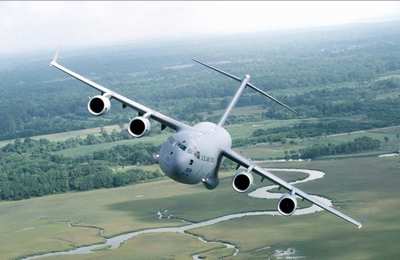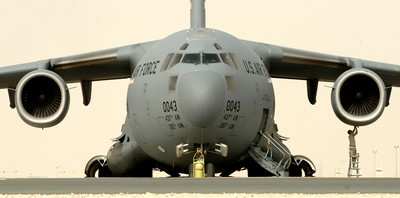Middling Deal Means Two New Orders For Boeing
It's not a deal that will save the C-17 Globemaster II program
by any means...
but every new order helps. Boeing announced
this week an international consortium of 10 NATO members -- joined
by Partnership for Peace nations Sweden and Finland -- signed a
Memorandum of Understanding (MOU) on September 24 to acquire three
Boeing C-17 Globemaster III long-range cargo jets.

The agreement sets the stage for NATO's first major defense
purchase in 30 years.
Under the agreement with the US Department of Defense and the
NATO Airlift Management Agency, two of the advanced airlifters
would be purchased from Boeing, while a third would be provided by
the US Air Force. The aircraft would be assigned to NATO's Heavy
Airlift Wing and jointly operated by the nations from Papa Air
Base, Hungary. Delivery of the first aircraft could take place as
early as spring 2009.
Each participating nation will pay for a portion of a C-17
rather than an entire aircraft, allowing them to share a pooled
fleet. The 12 countries participating in NATO's Strategic Airlift
Capability (SAC) program are Bulgaria, Estonia, Finland, Hungary,
Lithuania, the Netherlands, Norway, Poland, Romania, Slovenia,
Sweden and the United States.
"The SAC will provide an important new capability to address the
critical alliance need for strategic airlift to support operations
in Afghanistan and elsewhere, as well as other national missions,
including EU and UN missions," said Peter Flory, NATO Assistant
Secretary General for Defense Investment. "It can also provide a
model for future capability development."
"The C-17 is built for the very missions that NATO has been
performing for decades," said Jean Chamberlin, Boeing vice
president and C-17 program manager. "The Globemaster III, now in
its 15th year of service, continues to be recognized as the
backbone of international airlift missions, supporting numerous
contingency, humanitarian relief, and peacekeeping efforts around
the world. It is with tremendous pride that we welcome NATO, Sweden
and Finland to the C-17 family."
The C-17 fleet will allow each nation to meet its airlift
requirements to support sovereign and multinational mission
requirements. NATO does not currently own a heavy airlift
capability and frequently contracts with nations such as the United
States and Russia for assistance with its heavy airlift
requirements. The MOU calls for Boeing to establish a facility at
Papa Air Base to provide C-17 logistics support under the current
Globemaster Support Partnership.
"We continue to see strong international interest in C-17s,"
said Tommy Dunehew, Boeing International C-17 program manager. "And
this NATO agreement is a reflection of that."
A high-wing, four-engine, T-tailed aircraft with a rear-loading
ramp, the C-17 can carry large combat equipment and troops or
humanitarian aid across international distances directly to small
austere airfields anywhere in the world. With a payload of up to
170,000 pounds, the C-17 can take off from a 7,600-foot airfield,
fly 2,400 nautical miles, and land in 3,000 feet or less.

There are 192 operational C-17s worldwide -- 178 with the US Air
Force; six with the Royal Air Force (UK); four with the Royal
Australian Air Force, and four with the Canadian Forces. Boeing
received a contract in July to provide the C-17 to Qatar, with
deliveries starting in late summer 2009.
 NTSB Final Report: Cozy Cub
NTSB Final Report: Cozy Cub ANN FAQ: Contributing To Aero-TV
ANN FAQ: Contributing To Aero-TV Classic Aero-TV: Seated On The Edge Of Forever -- A PPC's Bird's Eye View
Classic Aero-TV: Seated On The Edge Of Forever -- A PPC's Bird's Eye View ANN's Daily Aero-Linx (04.29.25)
ANN's Daily Aero-Linx (04.29.25) ANN's Daily Aero-Term (04.29.25): Execute Missed Approach
ANN's Daily Aero-Term (04.29.25): Execute Missed Approach




